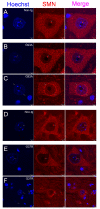Nuclear localization of human SOD1 and mutant SOD1-specific disruption of survival motor neuron protein complex in transgenic amyotrophic lateral sclerosis mice
- PMID: 22249462
- PMCID: PMC3432922
- DOI: 10.1097/NEN.0b013e318244b635
Nuclear localization of human SOD1 and mutant SOD1-specific disruption of survival motor neuron protein complex in transgenic amyotrophic lateral sclerosis mice
Abstract
Amyotrophic lateral sclerosis (ALS) is a fatal adult-onset neurodegenerative disease that causes degeneration of motor neurons and paralysis. Approximately 20% of familial ALS cases have been linked to mutations in the copper/zinc superoxide dismutase (SOD1) gene, but it is unclear how mutations in the protein result in motor neuron degeneration. Transgenic (tg) mice expressing mutated forms of human SOD1 (hSOD1) develop clinical and pathological features similar to those of ALS. We used tg mice expressing hSOD1-G93A, hSOD1-G37R, and hSOD1-wild-type to investigate a new subcellular pathology involving mutant hSOD1 protein prominently localizing to the nuclear compartment and disruption of the architecture of nuclear gems. We developed methods for extracting relatively pure cell nucleus fractions from mouse CNS tissues and demonstrate a low nuclear presence of endogenous SOD1 in mouse brain and spinal cord, but prominent nuclear accumulation of hSOD1-G93A, -G37R, and -wild-type in tg mice. The hSOD1 concentrated in the nuclei of spinal cord cells, particularly motor neurons, at a young age. The survival motor neuron protein (SMN) complex is disrupted in motor neuron nuclei before disease onset in hSOD1-G93A and -G37R mice; age-matched hSOD1-wild-type mice did not show SMN disruption despite a nuclear presence. Our data suggest new mechanisms involving hSOD1 accumulation in the cell nucleus and mutant hSOD1-specific perturbations in SMN localization with disruption of the nuclear SMN complex in ALS mice and suggest an overlap of pathogenic mechanisms with spinal muscular atrophy.
Figures







Similar articles
-
Nuclear Localization of Human SOD1 in Motor Neurons in Mouse Model and Patient Amyotrophic Lateral Sclerosis: Possible Links to Cholinergic Phenotype, NADPH Oxidase, Oxidative Stress, and DNA Damage.Int J Mol Sci. 2024 Aug 22;25(16):9106. doi: 10.3390/ijms25169106. Int J Mol Sci. 2024. PMID: 39201793 Free PMC article.
-
Human Cu/Zn superoxide dismutase (SOD1) overexpression in mice causes mitochondrial vacuolization, axonal degeneration, and premature motoneuron death and accelerates motoneuron disease in mice expressing a familial amyotrophic lateral sclerosis mutant SOD1.Neurobiol Dis. 2000 Dec;7(6 Pt B):623-43. doi: 10.1006/nbdi.2000.0299. Neurobiol Dis. 2000. PMID: 11114261
-
Survival motor neuron deficiency enhances progression in an amyotrophic lateral sclerosis mouse model.Neurobiol Dis. 2009 Jun;34(3):511-7. doi: 10.1016/j.nbd.2009.03.005. Epub 2009 Mar 28. Neurobiol Dis. 2009. PMID: 19332122
-
Transgenic mice with human mutant genes causing Parkinson's disease and amyotrophic lateral sclerosis provide common insight into mechanisms of motor neuron selective vulnerability to degeneration.Rev Neurosci. 2007;18(2):115-36. doi: 10.1515/revneuro.2007.18.2.115. Rev Neurosci. 2007. PMID: 17593875 Review.
-
Transgenic mouse model for familial amyotrophic lateral sclerosis with superoxide dismutase-1 mutation.Neuropathology. 2001 Mar;21(1):82-92. doi: 10.1046/j.1440-1789.2001.00361.x. Neuropathology. 2001. PMID: 11304046 Review.
Cited by
-
Gem depletion: amyotrophic lateral sclerosis and spinal muscular atrophy crossover.CNS Neurosci Ther. 2014 Jul;20(7):574-81. doi: 10.1111/cns.12242. Epub 2014 Mar 19. CNS Neurosci Ther. 2014. PMID: 24645792 Free PMC article. Review.
-
Mitochondrial DNMT3A and DNA methylation in skeletal muscle and CNS of transgenic mouse models of ALS.Front Cell Neurosci. 2013 Dec 25;7:279. doi: 10.3389/fncel.2013.00279. eCollection 2013. Front Cell Neurosci. 2013. PMID: 24399935 Free PMC article.
-
An Optimized Comparative Proteomic Approach as a Tool in Neurodegenerative Disease Research.Cells. 2022 Aug 26;11(17):2653. doi: 10.3390/cells11172653. Cells. 2022. PMID: 36078061 Free PMC article. Review.
-
The Small-Molecule Flunarizine in Spinal Muscular Atrophy Patient Fibroblasts Impacts on the Gemin Components of the SMN Complex and TDP43, an RNA-Binding Protein Relevant to Motor Neuron Diseases.Front Mol Biosci. 2020 Apr 17;7:55. doi: 10.3389/fmolb.2020.00055. eCollection 2020. Front Mol Biosci. 2020. PMID: 32363199 Free PMC article.
-
ALS-causative mutations in FUS/TLS confer gain and loss of function by altered association with SMN and U1-snRNP.Nat Commun. 2015 Jan 27;6:6171. doi: 10.1038/ncomms7171. Nat Commun. 2015. PMID: 25625564 Free PMC article.
References
-
- Chou SM. Pathology-light microscopy of amyotrophic lateral sclerosis. In: Smith RA, editor. Handbook of Amyotrophic Lateral Sclerosis. Marcel Deckker, Inc.; New York, NY: 1992. pp. 133–81.
-
- Rowland LP, Shneider NA. Amyotrophic lateral sclerosis. N Engl J Med. 2001;344:1688–1700. - PubMed
-
- Bendotti C, Carrì MT. Lessons from models of SOD1-linked familial ALS. Trends Mol Med. 2004;10:393–400. 2004. - PubMed
-
- Kabashi E, Valdmanis PN, Dion P, et al. TARDBP mutations in individuals with sporadic and familial amyotrophic lateral sclerosis. Nat Genet. 2008;40:572–4. - PubMed
-
- Turner BJ, Talbot K. Transgenics, toxicity and therapeutics in rodent models of mutant SOD1-mediated familial ALS. Prog Neurobiol. 2008;85:94–134. - PubMed
Publication types
MeSH terms
Substances
Grants and funding
LinkOut - more resources
Full Text Sources
Medical
Molecular Biology Databases
Miscellaneous

